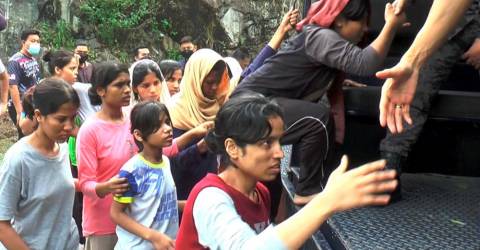60% of smuggled children forced into sex trade: NGO president

PETALING JAYA: As of this year, Malaysia has been upgraded to the Tier 2 Watchlist in the US State Department Trafficking in Persons (TIP) report, after making significant efforts to stem human trafficking.
“The government identified 180 confirmed trafficking victims – 36 exploited in sex trafficking and 144 exploited in forced labour – among 510 potential victims identified,” said the report.
Compared with the 2022 TIP report, Malaysia had successfully increased efforts in investigating and prosecuting trafficking operations, where authorities identified 96 trafficking victims among 373 potential victims in 2022.
Malaysian Humanitarian and Welfare Association president Dr Nithiya Thiahhan said although there is an improvement, child trafficking is still a common occurrence in Malaysia.
“Statistics on child trafficking in Malaysia, which are based only on officially reported cases of child trafficking, do not show the true scale of the issue. We must also consider unreported cases of migrants, who are afraid to make reports.”
She said foreign children trafficked into Malaysia are more vulnerable compared with Malaysian children because they often have no documentation and are without family, adding that this makes them easy targets for traffickers to exploit.
Nithiya revealed that the range of children trafficked could be from babies to teenagers.
“They come from neighbouring countries such as Thailand, Myanmar, Vietnam, Indonesia and Bangladesh. Babies are brought over to be sold to couples with fertility issues, and teenagers are often used for sex work or forced labour.
“Almost 60% of the children trafficked are made to do sex work while 30% are sold as babies. The remaining 10% are subjected to forced labour like begging or working in oil palm plantations.”
Tharani Cecil James Arunasalam, the project coordinator of Suka Society, which is an NGO set up to protect and preserve the interests of children, said Malaysia is a prime destination for trafficked children.
“Malaysia has a large demand for workers, especially in factories and plantations. This opens an opportunity for migrants to look for jobs but it also becomes an avenue for exploitation. These migrant workers are deceived into coming to Malaysia in hopes of better paying jobs but they are instead exploited.
“Their countrymen who deceive them are often their own family or neighbours, who promise them paradise before transporting them to Malaysia to be exploited for sex work or forced labour.”
Nithiya, who is also a lawyer dealing with human rights and child sexual abuse, said it is hard to identify such victims as authorities have inconsistently used victim identification procedures, adding that the authorities may have wrongly detained, arrested or deported some victims and prevented them from receiving protection services.
“It becomes extremely hard for these victims to escape their captors because the trafficking syndicates are huge and they have support from local gangs as well as some corrupt officials. Victims must be willing to identify themselves to receive help.”
Tharani, a protection officer and victim assistant specialist at the Home Ministry, said a lot has been done this past year to combat child trafficking.
“While Malaysia has done better in drafting and amending policies such as the Employment Act of 1955, which creates a new avenue to prosecute people involved in labour trafficking, there is still more to be done. It is important to treat trafficking victims with compassion and understanding.
“Programmes must involve gender-specific and trauma-related approaches, and more awareness must be spread on the issue, especially to victims. We teach them about the causes of trafficking in hopes that they return to their home countries and spread this knowledge so there will be fewer repeating cases.”
She said the government has also cooperated with Bangladesh, Thailand, Myanmar and Indonesia to curb trafficking and facilitate the repatriation of victims.
This “Eyes on Trafficking” story is reprinted from its original online location.
Fair Use Notice: The PBJ Learning Knowledge Vault is dedicated to advancing understanding of various social justice issues, including human trafficking and related topics. Some of the material presented on this website may contain copyrighted material, the use of which has not always been specifically authorized by the copyright owner. We are making such material available in our efforts to promote education and awareness of these important issues. There is no other central database we are aware of, so we put this together for both historical and research purposes. Articles are categorized and tagged for ease of use. We believe that this constitutes a ‘fair use' of any such copyrighted material as provided for in section 107 of the US Copyright Law. In accordance with Title 17 U.S.C. Section 107, the material on this site is distributed without profit to those who have expressed a prior interest in receiving the included information for research and educational purposes. For more information on fair use, please visit: “17 U.S. Code § 107 – Limitations on exclusive rights” on Cornell Law School's Legal Information Institute.
 ABOUT PBJ LEARNING
ABOUT PBJ LEARNING
PBJ Learning is a leading provider of online human trafficking training, focusing on awareness and prevention education. Their interactive Human Trafficking Essentials online course is used worldwide to educate professionals and individuals how to recognize human trafficking and how to respond to potential victims. Learn on any web browser (even your mobile phone) at any time.
More stories like this can be found in your PBJ Learning Knowledge Vault.
EYES ON TRAFFICKING
This “Eyes on Trafficking” story is reprinted from its original online location.
ABOUT PBJ LEARNING
PBJ Learning is a leading provider of online human trafficking training, focusing on awareness and prevention education. Their interactive Human Trafficking Essentials online course is used worldwide to educate professionals and individuals how to recognize human trafficking and how to respond to potential victims. Learn on any web browser (even your mobile phone) at any time.
More stories like this can be found in your PBJ Learning Knowledge Vault.
